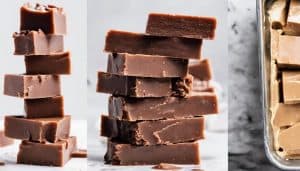You can freeze-dry candy at home using either dry ice or your home freezer, extending the shelf life of your favorite treats and preserving their flavors and textures. Prepare your candy by removing it from packaging, separating types to prevent flavor mixing, and arranging them evenly on a tray. Use dry ice in a cooler or your home freezer to freeze-dry the candy. Monitor the candy's moisture levels and store the freeze-dried treats in air-tight containers. With the right methods and precautions, you can enjoy crispy, long-lasting candies – and discover more secrets to perfecting this process.
Key Takeaways
• Remove candy from original packaging and separate different types to prevent flavor mixing before freeze-drying.
• Arrange candy evenly on a tray and consider cutting larger pieces into smaller chunks for efficient freeze-drying.
• Use dry ice and a cooler or your home freezer to freeze-dry candy, following specific temperature and time guidelines.
• Monitor candy's surface for signs of moisture and texture for dryness during the freeze-drying process.
• Store freeze-dried candy in air-tight containers in a cool, dry place to maintain freshness and texture.
Choosing the Right Freeze-Drying Method
When it comes to freeze-drying candy at home, you have two options: the rapid dry ice method and the slower freezer method, each with its own unique requirements and advantages.
The dry ice method is a speedy option, capable of freeze-drying candy in just 48 hours. This method requires a cooler and dry ice, making it a convenient choice for those short on time.
On the other hand, the freezer method takes a more leisurely approach, requiring a parchment-lined tray in the freezer and a period of time spanning 2-3 weeks.
Both methods are effective in removing moisture, thereby extending the shelf life of the candy. However, professional freeze-dried candy often tastes better due to the specialized equipment used in commercial settings.
Nevertheless, both methods can enhance the flavor, texture, and nutritional value of the candy, making it more portable and convenient.
When deciding between the two methods, consider the time you have available. If you're in a hurry, the dry ice method might be the way to go. However, if you're willing to wait, the freezer method can be a more cost-effective option.
Ultimately, the choice between the rapid dry ice method and the slower freezer method depends on your specific needs and preferences.
Preparing Candy for Freeze-Drying

Before loading your candy into the freeze dryer or freezer, take a few minutes to prepare it properly to guarantee the best results. You'll need to remove the candy from its original packaging to allow for better air circulation during the freeze-drying process. This step is essential to make sure your candy freeze-dries evenly and efficiently.
Next, separate different types of candy to prevent flavors from mixing during the process. You wouldn't want your sweet treats to end up with an unintended flavor profile, would you? Make sure to keep similar candies together, like grouping all the sour candies or all the chocolates.
When arranging the candy on the baking tray, make sure the pieces are evenly spaced to promote even freeze-drying. You can use parchment paper to prevent the candy from sticking to the tray during the freezing process.
Consider cutting larger candy pieces into smaller chunks for more efficient freeze-drying. This will help you achieve a better texture in your final freeze-dried candy.
Working With Dry Ice and Coolers
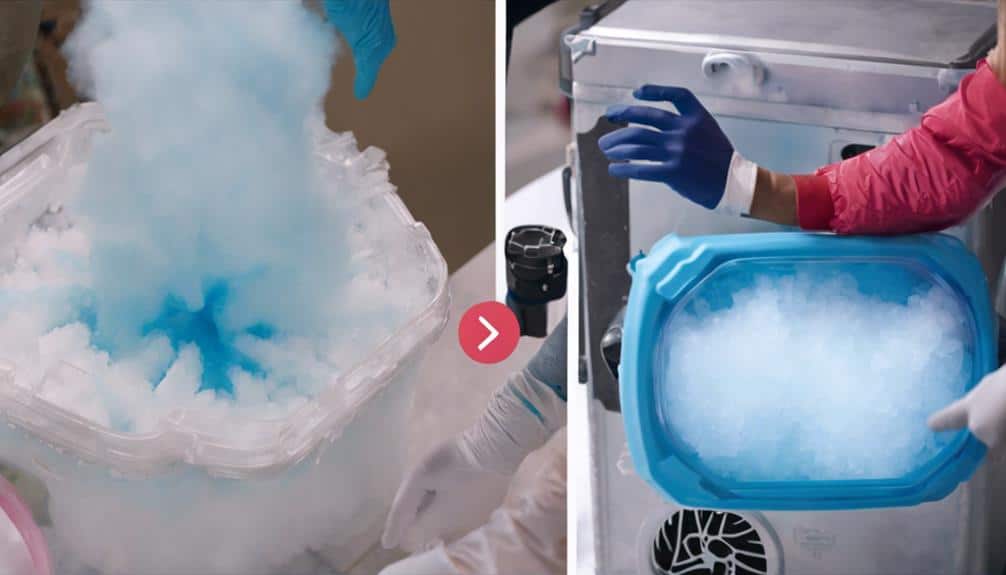
To guarantee safe and effective freeze-drying, you'll need to handle dry ice with caution and follow proper procedures. When using dry ice to freeze-dry candy, make sure to follow safety instructions to prevent accidents.
Here's a step-by-step guide to working with dry ice and coolers:
| Step | Instructions |
|---|---|
| 1 | Place the candy in freezer bags and then place them in a cooler with dry ice to begin the freeze-drying process. |
| 2 | Cover the candy with dry ice and let it sit for at least 24 hours to remove moisture effectively. |
| 3 | Transfer the freeze-dried candy to new bags after the freezing process to ensure freshness. |
After the freezing process, store the freeze-dried candy in a cool, dry place to maintain its texture and taste. Handling dry ice carefully is crucial, as it can be hazardous if not managed properly. When working with dry ice, always wear gloves and safety goggles to protect yourself from the extreme cold. Typically, two to three pounds of dry ice are sufficient for a small batch of candy. By following these steps and taking necessary precautions, you'll be able to achieve successful freeze-drying results at home.
Freeze-Drying in Your Home Freezer

How long does it take to freeze-dry candy in your home freezer, and what conditions are required for successful results?
To freeze-dry candy at home, you'll need to place the candy on a parchment-lined baking tray and store it in your home freezer for 2-3 weeks. This timeframe allows for the effective removal of moisture, preserving the candy's texture and flavor.
During this period, it's essential to maintain a consistent freezing temperature to facilitate the freeze-drying process. A deep freezer is ideal for this process, as it can maintain a consistent low temperature.
After the freeze-drying process, you can store the candy in freezer bags to preserve its texture and flavor.
When you're ready to consume the freeze-dried candy, allow it to come to room temperature for the best taste experience. This method is a cost-effective way to freeze-dry candy at home without the need for specialized equipment.
Monitoring Candy Moisture Levels
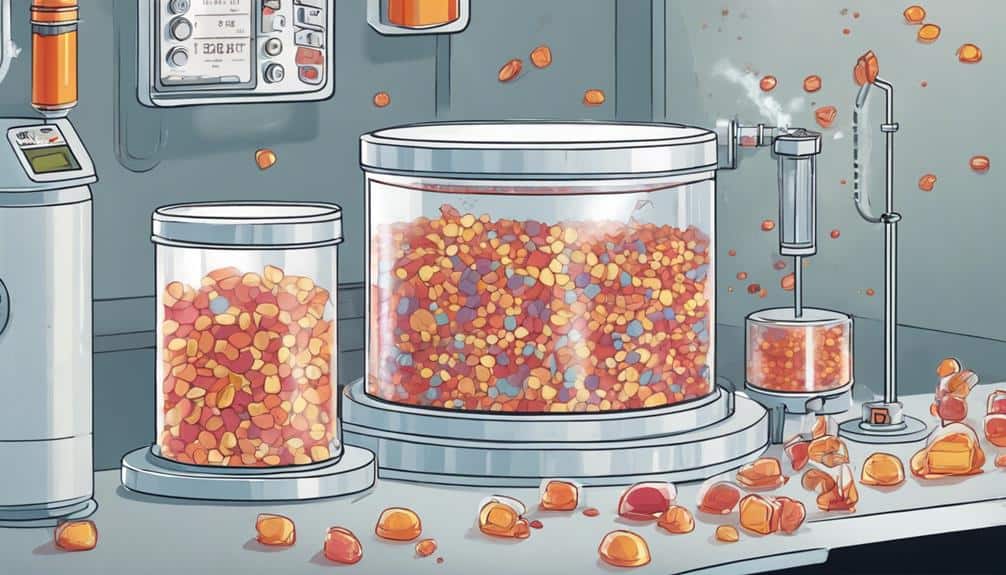
As you monitor the candy's progress, keep a close eye on the moisture levels to guarantee the freeze-drying process is proceeding at its best. You'll want to observe the candy's surface for any visible signs of moisture, such as condensation or stickiness.
Additionally, use a hygrometer to measure the humidity levels in the freezer or cooler where the candy is being freeze-dried. This will give you an accurate reading of the environment's moisture levels.
Regularly check the candy's texture to see if it feels dry and crispy, indicating that the moisture has been removed. Keep track of the time the candy has been freeze-drying to ensure the best level of moisture removal without over-drying.
It's important to find the sweet spot, as under-drying can lead to spoilage, while over-drying can make the candy brittle.
To make sure the candy is fully dry, test it by breaking it apart to check for any remaining moisture or soft spots. If you notice any, it's best to continue the freeze-drying process until the candy reaches the desired level of dryness.
Storing Freeze-Dried Candy Properly

Now that you've successfully freeze-dried your candy, it's important to store it properly to maintain its texture and flavor.
You'll need to focus on controlling moisture and keeping your treats away from contaminants.
Air-Tight Containers Matter
You'll need to store your freeze-dried candy in air-tight containers to prevent moisture from re-entering and compromising the candy's texture and flavor. This is vital for maintaining the quality of your freeze-dried treats. Air-tight containers, such as mason jars or vacuum-sealed bags, are ideal for storing freeze-dried candy. Make sure the containers are completely sealed to protect the candy from humidity and air exposure.
When storing your freeze-dried candy, it's important to keep the containers in a cool, dry place away from direct sunlight. This will help preserve the candy's texture and flavor for a longer period. Remember, proper storage is key to enjoying your freeze-dried candy for a longer time.
Moisture Control Is Key
Ensuring optimal moisture levels is crucial for storing freeze-dried candy and maintaining its texture, flavor, and overall quality.
You'll want to store your freeze-dried treats in airtight containers to prevent moisture absorption, which can cause the candy to become soggy or develop off-flavors. Additionally, keep your stored candy away from direct sunlight and high humidity to preserve its quality.
For longer-term storage, consider using desiccant packets or oxygen absorbers to control moisture levels. Properly sealed, your freeze-dried candy can last for several months to a few years.
However, it's important to regularly check your stored candy for any signs of moisture or changes in texture or color. If you notice any of these signs, it's best to err on the side of caution and discard the candy.
Tips for Freeze-Drying Different Candies
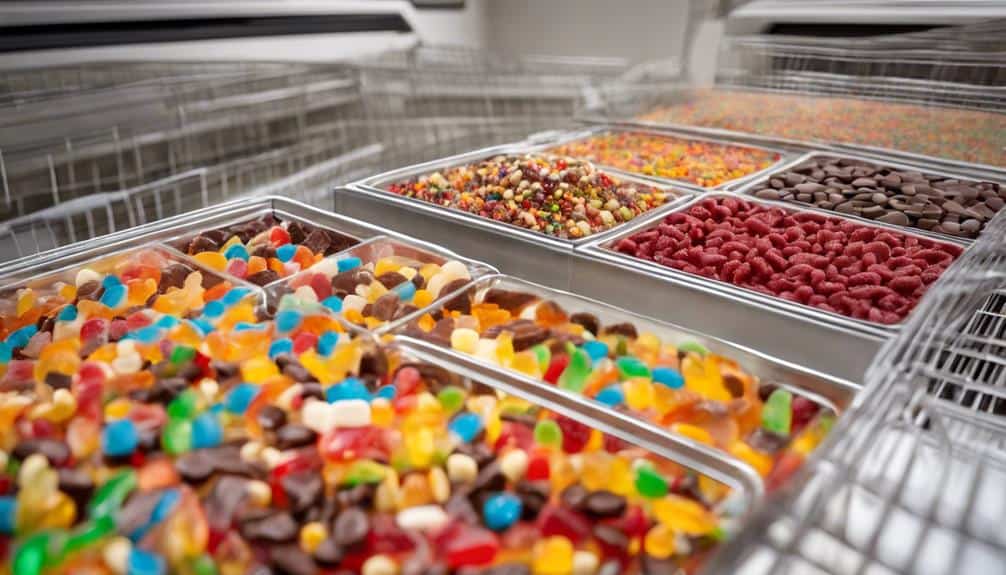
By experimenting with various types of candies, you can uncover which ones retain their texture and flavor best after freeze-drying, and which ones don't make the cut. You'll find that gummy candies like peach rings and sour worms transform into crunchy, shelf-stable treats that are perfect for snacking on-the-go.
Hard candies, too, can be freeze-dried to maintain their shape and intensity of flavor. However, be cautious when attempting to freeze-dry chocolate-covered candies, as the chocolate may melt during the process, compromising the final product.
When selecting candies to freeze-dry, consider their sugar content. Candies with high sugar content may crystallize during the freeze-drying process, affecting their texture and appearance. Experiment with different types of candies to find the ones that freeze-dry successfully at home. You might be surprised at which ones thrive under these conditions.
Troubleshooting Common Freeze-Drying Issues
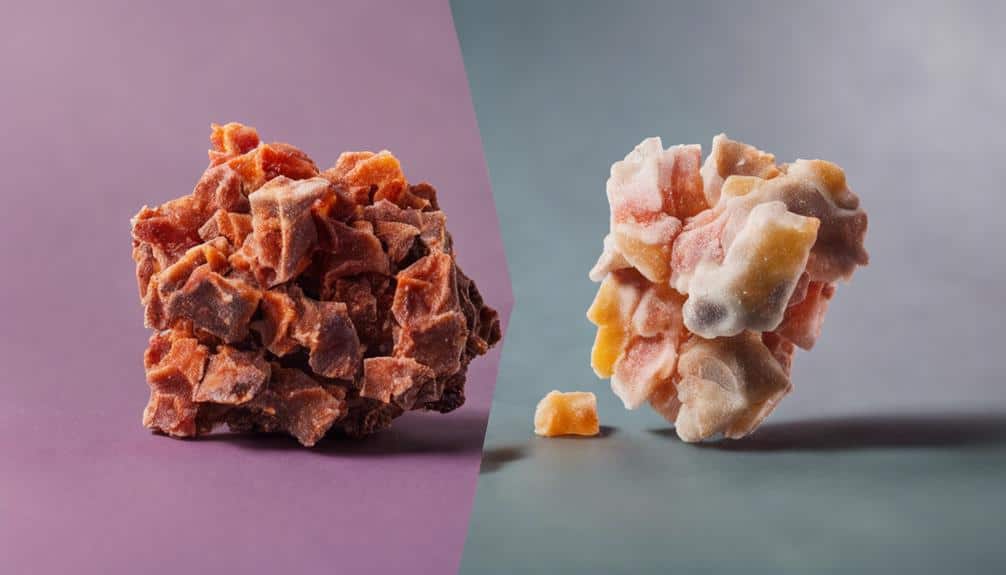
As you navigate the freeze-drying process, you'll likely encounter some common issues.
You might notice clogged freeze dryer vents, incomplete drying cycles, or frost formation problems that can impact the quality of your freeze-dried candy.
Clogged Freeze Dryer Vents
You can prevent freeze dryer vent clogs, a common issue that hampers the freeze-drying process, by regularly inspecting and cleaning your vents. Clogged vents can lead to uneven freeze-drying results and longer processing times, affecting the quality of the final product.
To clear clogged freeze dryer vents, remove any debris or obstructions that may be blocking the airflow. Use a vacuum cleaner or compressed air to clean out any dust or particles that could be causing the clog. Regular maintenance of freeze dryer vents is essential for efficient and effective freeze-drying of candy and other foods.
Here's a quick guide to help you troubleshoot and prevent clogged vents:
| Symptom | Cause | Solution |
|---|---|---|
| Reduced airflow | Debris in vents | Clean vents with vacuum or compressed air |
| Uneven drying | Clogged vents | Inspect and clean vents regularly |
| Longer processing times | Inadequate airflow | Check and clean vents before each use |
| Poor product quality | Inconsistent drying | Regularly inspect and maintain vents |
| Freeze dryer malfunction | Clogged vents | Clean vents to prevent damage to freeze dryer |
Incomplete Drying Cycles
Incomplete drying cycles can be a frustrating issue in freeze-drying candy at home, resulting from inadequate freezing times or improper temperature control. If you're experiencing this issue, don't worry – it's easily troubleshooted.
First, make sure you've frozen your candy for the recommended duration. If you're using the freezer method, that's 2-3 weeks; with dry ice, it's 24 hours. Next, double-check your freezer or cooler temperature to make sure it's set correctly for freeze-drying candy.
While your candy is drying, keep an eye on it to make sure it's properly frozen and dried. You can also prevent incomplete drying cycles by properly sealing the bags containing the candy. This maintains the freezing environment and helps prevent moisture from entering the bag.
Frost Formation Issues
Frost formation during the freeze-drying process can be a significant issue, resulting in an unwanted texture and taste in your final product. This problem can arise from improper sealing of the candy or excess moisture in the freezer. To prevent frost formation, you should make sure your candy is sealed tightly in freezer bags, removing excess air before freezing. Additionally, check your freezer temperature to make certain it's set below 0°F (-18°C) to minimize frost formation.
If you notice frost or ice crystals on the surface of your freeze-dried candy, it's a sign that something has gone wrong. Frost formation can affect the texture and taste of your final product, so it's crucial to troubleshoot and address the issue promptly.
Properly sealed and stored freeze-dried candy shouldn't have visible frost or ice crystals on the surface. By taking the necessary precautions, you can avoid frost formation and achieve a high-quality, deliciously textured freeze-dried candy.
What is the Best Method for Freeze Drying Candy at Home?
The freezing candy process timeline is crucial when considering freeze-drying candy at home. The best method involves pre-freezing the candy to minimize moisture content. Then, use a vacuum-sealed container to freeze-dry the candy, keeping it fresh and preserving its flavor and texture.
Enjoying Your Freeze-Dried Candy Creations

With your freshly freeze-dried candy creations in hand, it's time to savor their unique textures and flavors. You've worked hard to preserve the candy, and now it's time to enjoy the fruits of your labor. To maintain their freshness and flavor, store your freeze-dried candy creations in a cool, dry place.
Experiment with different types of candy to see which ones freeze-dry best and offer unique textures and flavors. You might be surprised at how certain candies transform when freeze-dried. Share your creations with friends and family as a fun and tasty treat. Consider packaging your freeze-dried candy in small bags or containers for easy snacking on the go.
But don't stop there. Explore creative ways to incorporate freeze-dried candy into desserts, trail mixes, or as toppings for yogurt or ice cream. The possibilities are endless, and it's up to you to experiment and innovate.
Whether you're a foodie, a candy enthusiast, or just someone who loves trying new things, freeze-dried candy offers a world of possibilities. So go ahead, get creative, and enjoy your freeze-dried candy creations!
Frequently Asked Questions
Can You Freeze-Dry Candy Without a Machine?
You're wondering if you can freeze-dry candy without a machine. The answer is yes, you can!
You have two options: using your freezer or dry ice.
The freezer method takes 2-3 weeks, while dry ice can get the job done in just 48 hours.
Both methods require some patience, but they'll help preserve your candy, enhance its flavor and texture, and make it more portable.
How to Make Your Own Freeze-Dried Candy?
You're ready to take the next step and make your own freeze-dried candy from scratch! Start by selecting your favorite candies, like gummy bears or sour candies.
Then, freeze them to remove excess moisture.
Next, place them in airtight containers or bags with silica gel packets to absorb any remaining moisture.
What Do People Use to Freeze-Dry Candy?
You might be surprised to know that 80% of DIY enthusiasts opt for dry ice to freeze-dry candy at home.
When it comes to freeze-drying candy, you can use either dry ice or freezers. With dry ice, you'll place the candy in a cooler for 48 hours, while freezers require freezing the candy on a tray for 2-3 weeks.
Both methods effectively remove moisture, enhancing flavor, texture, and nutritional value.
Can You Use a Food Dehydrator to Freeze-Dry Candy?
You might think a food dehydrator can substitute for a freeze dryer, but it's not a suitable alternative.
Dehydrators operate at higher temperatures, which can melt or caramelize candy, altering its texture and flavor. They also can't fully remove moisture, affecting the candy's quality.
If you want to preserve the original texture, flavor, and nutrients, it's best to use a dedicated freeze dryer designed for the task.
Conclusion
With your freeze-dried candy creations in hand, the sweet possibilities are endless. Like a master chef, you've orchestrated a symphony of flavors and textures, coaxing out the essence of each treat.
Now, as you savor the fruits of your labor, remember that freeze-drying is an art that requires patience, precision, and practice. As you continue to experiment and innovate, your skills will crystallize, much like the sugary crystals that now dance on your tongue.

